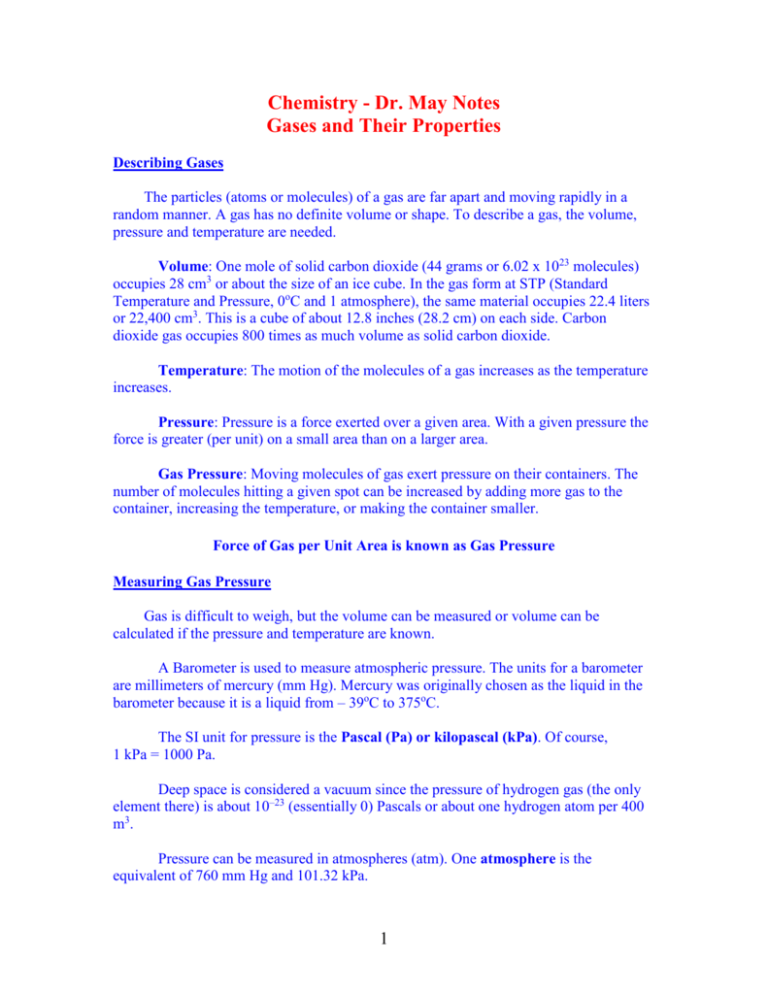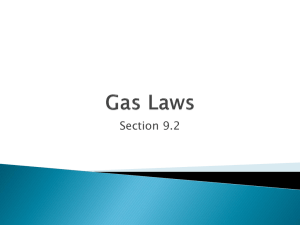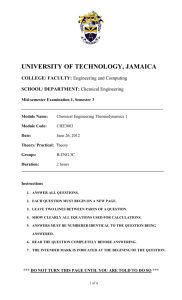Chemistry
advertisement

Chemistry - Dr. May Notes Gases and Their Properties Describing Gases The particles (atoms or molecules) of a gas are far apart and moving rapidly in a random manner. A gas has no definite volume or shape. To describe a gas, the volume, pressure and temperature are needed. Volume: One mole of solid carbon dioxide (44 grams or 6.02 x 1023 molecules) occupies 28 cm3 or about the size of an ice cube. In the gas form at STP (Standard Temperature and Pressure, 0oC and 1 atmosphere), the same material occupies 22.4 liters or 22,400 cm3. This is a cube of about 12.8 inches (28.2 cm) on each side. Carbon dioxide gas occupies 800 times as much volume as solid carbon dioxide. Temperature: The motion of the molecules of a gas increases as the temperature increases. Pressure: Pressure is a force exerted over a given area. With a given pressure the force is greater (per unit) on a small area than on a larger area. Gas Pressure: Moving molecules of gas exert pressure on their containers. The number of molecules hitting a given spot can be increased by adding more gas to the container, increasing the temperature, or making the container smaller. Force of Gas per Unit Area is known as Gas Pressure Measuring Gas Pressure Gas is difficult to weigh, but the volume can be measured or volume can be calculated if the pressure and temperature are known. A Barometer is used to measure atmospheric pressure. The units for a barometer are millimeters of mercury (mm Hg). Mercury was originally chosen as the liquid in the barometer because it is a liquid from – 39oC to 375oC. The SI unit for pressure is the Pascal (Pa) or kilopascal (kPa). Of course, 1 kPa = 1000 Pa. Deep space is considered a vacuum since the pressure of hydrogen gas (the only element there) is about 10–23 (essentially 0) Pascals or about one hydrogen atom per 400 m3 . Pressure can be measured in atmospheres (atm). One atmosphere is the equivalent of 760 mm Hg and 101.32 kPa. 1 1 atm = 101.325 kPa (standard pressure) Units of Pressure Unit Equivalence of 1kPa Pascal (Pa) 1 kPa = 1000 Pa Atmosphere (atm) 1 kPa = 0.009869 atm Bar 1 kPa = 0.01 bar Torr 1 kPa = 7.501 torr Millimeter of Hg (mm Hg) 1 kPa = 7.501 mm Hg Pounds per sq. inch (psi) 1 kPa = 0.145 psi A device similar to a barometer that is used to measure gas pressure is called a manometer. Dalton’s Law of Partial Pressure A gas can be collected by a method called water displacement. However, a small amount of water vapor (gaseous water) will be mixed with the gas collected. Each gas has its own pressure called the Partial Pressure. The total pressure is equal to the sum of the partial pressures: Ptotal = Phydrogen + Pwater This is called Dalton’s Law of Partial Pressures. Relationships among Gas Properties: Charles’s Law: The Temperature-Volume Relationship (Jacques Charles) Charles Law states that when the pressure and the amount of a gas are held constant, the volume of the gas is directly proportional to its Kelvin temperature. V1 ‗ V2 T1 T2 The Kelvin scale for temperature is divided into increments called Kelvins. The relationship between temperature in Kelvins (T) and Celsius degrees (t) is: T = t + 273 For example: 0oC = 273 K Solving the following example using the Dr. May method: A gas occupies 473 cm3 at 36.0oC, what is the volume at 94oC? (Assume pressure and number of moles stay constant.) 2 94.0oC + 273 = 367 K 36.0oC + 273 = 309 K V1 ‗ V2 T1 T2 473 cm3 ‗ V2 309 K 367 K 309 V2 = 473 x 367 V2 = 173,591 ÷ 309 V2 = 561.8 cm3 Boyle’s Law: The Pressure-Volume Relationship (Robert Boyle, 1660) Boyle’s Law states that when the temperature and the number of moles of a sample of gas are held constant, its volume is inversely proportional to the pressure applied. P1V1 = P2V2 Solving the following example using the Dr. May method: A sample of gas has a volume of 100.0 cm3 when the pressure is 150 kPa, what is the volume when the pressure is increased to 200.0 kPa? (Temperature and moles of gas remain constant.) P1V1 = P2V2 200.0 kPa x V2 200 V2 V2 V2 = = = = 150.0 kPa x 100 cm3 15000 15000 ÷ 200 75 cm3 Avogadro’s Principle Joseph Gay-Lussac conceived of the Law of Combining Volumes: Whenever gases react under the same conditions of temperature and pressure, the volume ratios of the elements can be expressed as simple whole numbers. Compound 1 Compound 2 Compound 3 Combining Volume of Gases Volume of Volume of Volume ratio of nitrogen oxygen (ml) nitrogen : oxygen 100 49.5 2:1 100 108.9 1:1 100 204.7 1:2 3 Accepted formula N2O NO NO2 Amadeo Avogadro hypothesized that: Equal volumes of gases (at the same temperature and pressure) contain equal numbers of particles. Avogadro stated that this very simply explained Gay-Lassac’s law of combining volumes. Mathematically it can be shown that as the number of moles of a gas increases the volume increases. Combined Gas Law The Combined Gas Law includes Boyle’s and Charles Law and can be used for any gas problem where conditions change. P1V1 ‗ P2V2 T1 T2 P = pressure, and calculations can be done when P is in millimeters of Hg (mm), kilopascals (kPa), or atmospheres (atm) as long as both pressures are in the same units. Standard pressure is 760 mm, 101.32 kPa, or 1 atm. T = temperature, and calculations can be done only when T is in Kelvins. Standard temperature is 273 K or 0oC. V = volume of gas and calculations can be done when V is in any unit as long as both volumes are in the same units. The most common units are liters (L), milliliters (ml), and cubic centimeters (cm3). One mole of gas at STP (0oC and 1 atm) occupies 22.4 liters. 4








